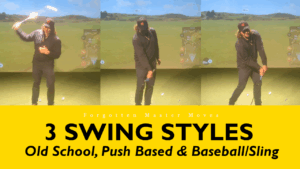
Minor Swing Fix: Intentions Makes AND Breaks Your Swing
Most golfers manipulate their motion in one way or another, which eventually leads to the need for minor swing fix.
After all, most of your golf shots will be less than perfect. Or as Ben Hogan roughly said, “I hit two shots the way I want per round”—and he’s arguably the greatest ball striker of all time.
When you’re not manipulating your swing, it feels like you’re in perfect harmony with the game, and everything flows effortlessly. But for the rest of the time, we need a mindset that helps us understand where we stand in the balance of our intentions.
In my world, at least 50% of my golf swing is driven by intentions. Intentions are essentially brain coordinates that make mechanical instruction and thoughts feasible from an execution standpoint.
But intentions can also be strong manipulators. If relied on too frequently, they become swing poison—and need an antidote.
And just to be clear, this concept applies to swings that mostly work—not broken engines…
Minor Swing Fix – Example 1 – The Path Manipulator
If your intention is based on swing path, you’ll quickly move yourself out of the sweet spot for producing the shot shape you want.
Let these examples shed some light:
- When Tiger Woods won the 1997 Masters by 12 shots, word inside the ropes was that he felt like he was hitting a fade most of the time—but in reality, he was producing a smooth push draw on most shots.
- Wyndham Clark was in the absolute sweet spot during 2024, winning multiple big events in a short time. He has said that if he starts hitting too much fade, he trains his draw—and vice versa.
- Jack Nicklaus was often seen hitting draw shots on the range, yet he played his signature open-stance push fade 95% of the time on the course.
To summarize:
If you love the draw and use swing path as your go-to manipulator, you’ll eventually drop the club too far behind you and create excessive blade rotation through impact.
If you love the fade feel, you’ll eventually get too steep and come too much from the outside.
Example 2 – The Lagger vs Releaser
In my other article, I explain how, if you use the swing arc as your power engine, you’re essentially balancing the relationship between releasing the club and dragging the handle.
If your go-to intention is hitting punch shots, the result is often an increased lag-holding tendency and less centrifugal force release. Over time, this can also lead to a more out-to-in path.
On the other hand, if you’re frequently hitting high, reach-for-the-sky shots with less compression, you’re likely applying a more upward intentional manipulation of the club.
The antidote?
Simply do the opposite—if you’re hitting too many punch shots, train high shots. If you’re hitting too many high shots, work on lower, more compressed strikes.
Example 3 – The Intentional Rotator
Some protocols emphasize rotation and pivoting as the main driver of the entire motion. This is especially common in the more modern, baseball-like swing that some tour pros use.
If you’re intentionally using rotation to control your strike, you’ll often start coming too much from the outside. Most of the time, this happens because you rotate too early, which puts the club on an outside path long before impact. The rotational movement then pulls the arms too quickly toward the ball.
The counter to this is to hit a non-rotational out-to-in shot (which isn’t exactly a great recipe for scoring well) or a sling hook. Why? Because you need to get your arms working back in relation to the target. In my opinion, this is a much simpler fix than trying to force some complicated transition drill that only makes real swing execution more difficult.
Summary – Minor Swing Fix Concept – The Antidote Mindset
I just gave three examples of slight manipulations, but there are many more. What’s your go-to manipulating intention?
Figure that out, then identify the antidote for overtraining it. Once you do, you’ll start to find the balance that leads to better, more consistent ball striking.
In the FMM swing system, I focus on teaching a motion where manipulation plays a smaller role than in most swing styles I’ve used. Check it out here.
Swing Knowledge and Flaws Articles

A Shallow Golf Swing – Which Move Creates the Magic?
How is it that many tour pros don’t visibly shallow their golf club early in the downswing, yet still deliver…

Harvey Penick Magic Move – In Different Variations
The original Harvey Penick Magic Move refers to a simple gravitational drop of the arms toward your pocket, combined with…

Releasing the Golf Club vs Holding Lag – Which is Better?
If you use your swing arc as your main power source, you are ultimately balancing the relationship between releasing the…
Major Swing Change Article Series

Basic Swing Change Tips: Small Advice with Big Potential
Making a swing change can be challenging and requires more than most golfers realize. To successfully change any part of your swing, you typically need between 3,000 to 5,000 repetitions (based on my experience)….

Asking Successful Swing Change Questions – Where to Go?
You’ve probably figured out by now that I’m not someone who promotes “quick fixes.” Instead, I focus on the deeper foundations of swing change efforts. In all honesty, there’s no other way to make…

Understanding your Golf Swing DNA – Where You Are Now
Understanding who you are as a golfer—your current swing, habits, and the motivations behind them—is the foundation of any meaningful swing change. Without this self-awareness, you have no solid ground to build upon. You…
Some General Swing Tech Posts (with Videos)

An Invisible Golf Swing – How the Observation is Deceiving
The Golf Swing is Invisible? How the Effects of Intentions are hard to see What I do isn’t always what you see. What you do isn’t always what I see. The golf swing is…

Long Journey Swing Arc – Harmonic Golf Swing
Long Journey Swing Arc – Harmonic Golf Swing The old-school swings where utilizing the swing arc actively all the way in their motion. This is a very long journey swing arc usage. Arnold Palmer…

3 Golf Swing Styles – Coverage to Navigate the Golf Jungle
3 Golf Swing Styles – Coverage to Navigate the Golf Jungle There are many different way to swing a golf club but I’ve pretty much narrowed it down to 3 golf swing styles in…
The FMM Swing Articles

Swing Thoughts Deep Dive: Should You Think in Golf?
You should never play “a mind full of mechanics golf swing” on a round of golf. I agree with that, but at the same time it’s hard not to think at all. For me,…

Your Golf Brain Is Stupid — It Demands Simple Coordinates
I’ve played golf for 35+ years and have been deeply researching the golf swing for at least 12–13 years at this point. One of the few statements I can make with absolute certainty is…

The Golf Swing Arc: The Leader Behind Your Motion
The highest level of swing technique is to be able to simplify the motion. Over the years I’ve been able to understand what matters and maybe even more importantly, what doesn’t matter, in a…